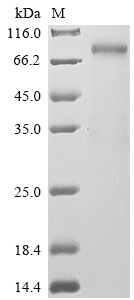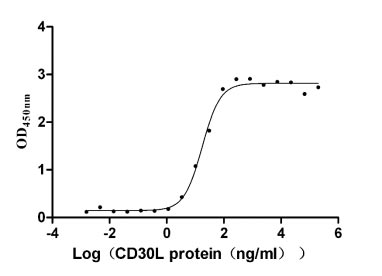Recombinant Human Syndecan-1 (SDC1), partial
-
货号:CSB-MP020888HU
-
规格:¥2376
-
图片:
-
其他:
产品详情
-
纯度:Greater than 85% as determined by SDS-PAGE.
-
基因名:
-
Uniprot No.:
-
别名:CD_antigen; CD138; CD138 antigen; heparan sulfate proteoglycan fibroblast growth factor receptor; SDC; Sdc1; SDC1_HUMAN; SYND1; Syndecan 1; Syndecan; syndecan proteoglycan 1; Syndecan-1
-
种属:Homo sapiens (Human)
-
蛋白长度:Partial
-
来源:Mammalian cell
-
分子量:51.3 kDa
-
表达区域:23-254aa
-
氨基酸序列QIVATNLPPEDQDGSGDDSDNFSGSGAGALQDITLSQQTPSTWKDTQLLTAIPTSPEPTGLEATAASTSTLPAGEGPKEGEAVVLPEVEPGLTAREQEATPRPRETTQLPTTHLASTTTATTAQEPATSHPHRDMQPGHHETSTPAGPSQADLHTPHTEDGGPSATERAAEDGASSQLPAAEGSGEQDFTFETSGENTAVVAVEPDRRNQSPVDQGATGASQGLLDRKEVLG
Note: The complete sequence including tag sequence, target protein sequence and linker sequence could be provided upon request. -
蛋白标签:C-terminal hFc-tagged
-
产品提供形式:Liquid or Lyophilized powder
Note: We will preferentially ship the format that we have in stock, however, if you have any special requirement for the format, please remark your requirement when placing the order, we will prepare according to your demand. -
缓冲液:If the delivery form is liquid, the default storage buffer is Tris/PBS-based buffer, 5%-50% glycerol.If the delivery form is lyophilized powder, the buffer before lyophilization is Tris/PBS-based buffer, 6% Trehalose, pH 8.0.
-
复溶:We recommend that this vial be briefly centrifuged prior to opening to bring the contents to the bottom. Please reconstitute protein in deionized sterile water to a concentration of 0.1-1.0 mg/mL.We recommend to add 5-50% of glycerol (final concentration) and aliquot for long-term storage at -20°C/-80°C. Our default final concentration of glycerol is 50%. Customers could use it as reference.
-
储存条件:Store at -20°C/-80°C upon receipt, aliquoting is necessary for mutiple use. Avoid repeated freeze-thaw cycles.
-
保质期:The shelf life is related to many factors, storage state, buffer ingredients, storage temperature and the stability of the protein itself.
Generally, the shelf life of liquid form is 6 months at -20°C/-80°C. The shelf life of lyophilized form is 12 months at -20°C/-80°C. -
货期:18-28 business days
-
注意事项:Repeated freezing and thawing is not recommended. Store working aliquots at 4°C for up to one week.
-
Datasheet & COA:Please contact us to get it.
相关产品
靶点详情
-
功能:Cell surface proteoglycan that bears both heparan sulfate and chondroitin sulfate and that links the cytoskeleton to the interstitial matrix. Regulates exosome biogenesis in concert with SDCBP and PDCD6IP.
-
基因功能参考文献:
- The research revealed identical overall epithelial Sdc1 expression in both breast carcinomas with no statistically significant difference in its stromal expression and confirmed the role of Sdc1 in the progression of both tumor types and in the development of ductal carcinoma's metastatic potential. PMID: 30151336
- Study demonstrated that miR494 is able to downregulate SDC1 expression, thereby inhibiting the progression of pancreatic cancer. PMID: 29956739
- High serum SDC1 expression is associated with chemotherapy-resistance in castration-resistant prostate cancer. PMID: 29628317
- E-Cadherin and epithelial syndecan-1 were more highly expressed in intraluminal/luminal unicystic ameloblastoma than in mural unicystic ameloblastoma and solid/multicystic ameloblastoma, whereas the stromal expression of syndecan-1 was higher in mural unicystic ameloblastoma and solid/multicystic ameloblastoma. PMID: 29850393
- evamisole inhibited CD138 expression and affected the levels of IL-6 in a dose-dependent manner. The results of the present study add new dimension to levamisole's mode of action as inhibitor of CD138 and IL-6 and as an antiapoptotic agent. PMID: 29798960
- serum level higher in control group than in early-onset or late-onset pre-eclampsia PMID: 28574293
- syndecan-1 levels were associated with not only the severity of illness and mortality but also disseminated intravascular coagulation development in sepsis, suggesting that syndecan-1 could be a predictive marker of disseminated intravascular coagulation PMID: 28843664
- our findings revealed that SDC1 suppressed EMT via the modulation of the ERK signaling pathway that, in turn, negatively affected the invasiveness of human oral cancer cells. Our results provided useful evidence about the potential use of SDC1 as a molecular target for therapeutic interventions in human oral cancer. PMID: 29484435
- The positive correlation between soluble Syndecan-1 levels and breast cancer tumor size in the present study highlights the importance of this molecule in the breast tumor progression and their significance as tumor biomarkers. PMID: 28382590
- our results identify the CD63-syntenin-1-ALIX complex as a key regulatory component in post-endocytic HPV trafficking. PMID: 27578500
- abrogation of nuclear translocation of syndecan-1 resulted in a set of changes clustering in distinct patterns, which highlighted the functional importance of nuclear syndecan-1 in hampering cell proliferation and the cell cycle PMID: 29216821
- findings support a key role for Sdc1 in modulating pulmonary protection by FFP after hemorrhagic shock. PMID: 28107214
- S1P induces advanced tumor phenotypes of hepatocellular carcinoma via establishing an MMP-7/syndecan-1/TGF-beta1 autocrine loop PMID: 27556509
- There was a close correlation between the expression of IL-17 and syndecan-1 in nasal mucosa epithelial cells, glandular epithelial cells, and inflammatory cells, suggesting that IL-17 and syndecan-1 may play a role, and interact with each other, in the pathogenesis of non- eosinophilic chronic rhinosinusitis with nasal polyps. PMID: 28585128
- the present study showed that serum Syndecan-1 might be a reliable marker for monitoring disease activity and renal activity in children with JSLE and lupus nephritis. PMID: 27838471
- The above suggest that radiation-mediated premature senescence and invasive tumor cells, alone or in combination, enhance SDC1 expression in breast stromal fibroblasts, a poor prognostic factor for cancer growth, and that TGF-beta plays a crucial role in this process. PMID: 27434331
- A syndecan-1 level >/=40 ng/mL identified trauma patients with significantly worse outcomes, despite admission physiology similar to those without the condition. PMID: 28579548
- MiR-331-3p-mediated miRNA maturation and enhanced epithelial-to-mesenchymal transition via effects on TGF-beta/Smad 4 and Dicer are essential for the development of prostate cancer mediated by syndecan-1. PMID: 26259043
- The heparanase/syndecan1 axis in gallbladder carcinoma cells plays an important role in the invasion and metastasis, thus providing a new therapeutic target. PMID: 28351285
- Syndecan-1 acts as a novel tissue biomarker and a modulator of CSC phenotype of triple negative IBC via the IL-6/STAT3, Notch and EGFR signaling pathways, thus emerging as a promising therapeutic target for IBC. PMID: 28270211
- Hepatitis C virus infection downregulates Synd-1 and upregulates Xylt 2 expression, likely contributing to a major glycocalyx reshuffle within days of infection. PMID: 27930836
- Soluble Sdc1 is significantly lower before the clinical onset of preeclampsia, with reduced expression of Sdc1 in the delivered placenta, suggesting a role for glycocalyx disturbance in preeclampsia pathophysiology. PMID: 27299886
- Heparanase has emerged as a major regulator of cancer by degrading heparan sulfate thereby influencing multiple signaling pathways that control gene expression, syndecan shedding and cell behavior. (Review) PMID: 27758044
- Study provides robust evidence in favor of the additional baseline soluble CD138 prognostic value for OS, in mCRC patients. A simple biological scoring system is proposed including LDH and CD138 binary status values. PMID: 27472156
- it is not appropriate to assume that CD138 expression in urothelial carcinomas is specific for plasmacytoid variants PMID: 27305940
- epithelial cytoplasmic expression of maspin and CD138 may have a significant role in tumorigenesis in ovarian high-grade serous carcinomas and clear cell carcinomas; these markers may regulate tumor cell proliferation, and their significant correlation to each other may suggest that CD138 probably induces maspin expression to protect tumor growth factors from being lysed by proteolytic enzymes PMID: 26526579
- High syndecan level is associated with sepsis. PMID: 26953518
- Systemic sclerosis (SSc) patients with elevated serum syndecan-1 levels had higher prevalence of telangiectasia, elevated right ventricular systolic pressure and decreased diffuse capacity of the lung for carbon monoxide than those with normal levels. Therefore, soluble syndecan-1 may be related to the development of proliferative vasculopathy in SSc patients. PMID: 26076711
- in colorectal adenomas, the heparanase-1 does not participate in syndecan-1 degradation; the heparanase-2 does not stimulate syndecan-1 degradation by the action of heparanase-1, and the heparanase-2 may be involved in the modulation of the heparanase-1 activity. PMID: 26972718
- Targeting Syndecan-1, a molecule implicated in the process of vasculogenic mimicry, enhances the therapeutic efficacy of the L19-IL2 immunocytokine in human melanoma xenografts. PMID: 26460958
- The new markers were able to identify a clonal CD138-negative population as minimal residual disease in the bone marrow and peripheral blood of MM patients. PMID: 26729247
- miR-145 suppresses syndecan-1 and, by this mechanism, up-regulates stem cell factors and induces cell senescence and differentiation. PMID: 26514209
- The results suggest that Sdc1 may modulate fibronectin fibrillogenesis and/or alter cell morphology during ECM production through alphavbeta3 integrin, thereby mediating ECM fiber alignment. PMID: 26909794
- Syndecan-1 on epithelial tumor cells promotes MIF binding and MIF-mediated cell migration. This may represent a relevant mechanism through which MIF enhances tumor cell motility and metastasis. PMID: 26852939
- SULF1 levels are lower in pleural malignancies compared to benign conditions and inversely correlate with the amounts of syndecan-1, suggesting important roles for syndecan-1 and SULF1 in malignant mesothelioma. PMID: 26210886
- Our study indicates that SDC1 expressed by the bone marrow microenvironment is involved in angiogenesis in MM. PMID: 25353275
- miR-302a plays a key role in inhibition of ovarian cancer cell proliferation, and enhancing apoptosis by targeting SDC1. PMID: 26191180
- The concentration of syndecan-1, a marker of glycocalyx damage measured during ED admission, is valuable in assessing the risk of developing AKI and in-hospital mortality. PMID: 25891890
- Sdc-1 may act as a modulator of ESC apoptosis and probably invasion depth as a crucial factor for successful pregnancy. PMID: 25830352
- Elevated levels of soluble CD138/Sdc-1 in older bladder cancer patients and those with muscular invasion sheds some light on the mechanisms of the disease invasion. PMID: 25115297
- demonstrate that HER2 is captured via a site, comprised of amino acids 210-240, in the extracellular domain of human Sdc1, and EGFR is captured via an extracellular site comprised of amino acids 87-131 in human Sdc4 PMID: 26350464
- stromal changes in the expression of SDC-1 may originate from the stroma and contribute to the pathogenesis and metastatic potential of epithelial ovarian carcinoma PMID: 26513873
- syndecan-1 has a role in glycocalyx shedding and is increased in patients with end-stage liver disease; ischemia-reperfusion injury during OLT further exacerbates glycocalyx shedding PMID: 25757215
- Data indicate that the extracellular and cytoplasmic domains of syndecans 1/2/3/4 are intrinsically disordered regions. PMID: 24956062
- HPV16 particles binds to heparan sulfate and syndecan-1 molecules present in the extracellular matrix. PMID: 26289843
- syndecan-1 may have a role as a biological and prognostic marker in patients with triple-positive breast carcinomas PMID: 25273930
- our findings identify heparanase as a modulator of the syndecan-syntenin-ALIX pathway, fostering endosomal membrane budding and the biogenesis of exosomes by trimming the heparan sulfate chains on syndecans PMID: 25732677
- Serum SDC-1 levels are increased in systemic lupus erythematosus patients with nephritis, indicating that SDC-1 might be a useful serum biomarker for active LN. PMID: 25512478
- Syndecan-1 expression is associated with tumor size and EGFR expression in colorectal carcinoma PMID: 25589885
- syndecan-1 in pleural effusions predicted a survival difference for patients with pleural metastatic disease and malignant mesothelioma. PMID: 25147801
显示更多
收起更多
-
亚细胞定位:Membrane; Single-pass type I membrane protein. Secreted. Secreted, extracellular exosome.
-
蛋白家族:Syndecan proteoglycan family
-
数据库链接:
HGNC: 10658
OMIM: 186355
KEGG: hsa:6382
STRING: 9606.ENSP00000254351
UniGene: Hs.224607
Most popular with customers
-
Recombinant Human Tumor necrosis factor receptor superfamily member 8 (TNFRSF8), partial (Active)
Express system: Mammalian cell
Species: Homo sapiens (Human)
-
Recombinant Mouse Prolactin receptor (Prlr), partial (Active)
Express system: Mammalian cell
Species: Mus musculus (Mouse)
-
Recombinant Human IL12B&IL12A Heterodimer Protein (Active)
Express system: Mammalian cell
Species: Homo sapiens (Human)
-
Recombinant Human Trophoblast glycoprotein (TPBG), partial (Active)
Express system: Mammalian cell
Species: Homo sapiens (Human)
-
Recombinant Human Tumor-associated calcium signal transducer 2 (TACSTD2), partial (Active)
Express system: Mammalian cell
Species: Homo sapiens (Human)
-
Recombinant Human Interleukin-2 (IL2) (Active)
Express system: Mammalian cell
Species: Homo sapiens (Human)
-
Recombinant Human Killer cell immunoglobulin-like receptor 3DL2 (KIR3DL2), partial (Active)
Express system: Mammalian cell
Species: Homo sapiens (Human)
-
Recombinant Macaca fascicularis CUB domain containing protein 1 (CDCP1), partial (Active)
Express system: Mammalian cell
Species: Macaca fascicularis (Crab-eating macaque) (Cynomolgus monkey)





















